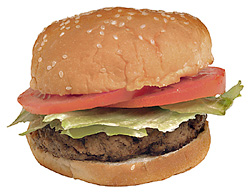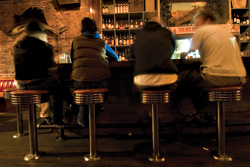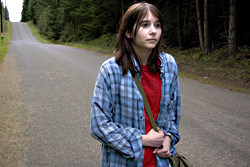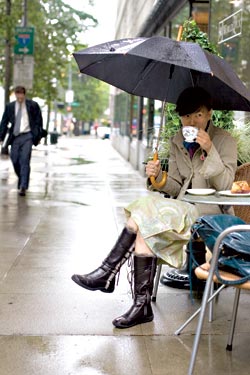We had this teacher in high school we called Mrs. Penis Head (horrible, I know) because her short hair had been the same for years: parted in the middle and feathered on the sides. We wondered in whispers why she still had that haircut in the early ’90s. As 16-year-olds who changed their styles every week, we didn’t get why she hadn’t taken cues from pop culture and updated her look. Even Madonna’s fake blond do or a spiral perm mimicking Nicole Kidman’s hair in Far and Away would’ve been an improvement.
Now that I’m older, I understand how people easily fall into fashion ruts— e.g., the khaki pants and blue shirt look—due to various factors (kids, too much work, lack of money, fear of the unknown, lack of interest, etc.). The question is: How can one find his or her fashion mojo again? Or, if one has never had a strong, personal style, how can she create one?
According to experts I surveyed, the first step is a touchy-feely one. You have to do some serious self-reflecting. “The process begins and ends with a strong sense of yourself,” says Angie Cox, a stylist, founder of YouLookFab.com, and member of Dress for Success’ advisory board. Cox considers budget, lifestyle, age, body type, and personality before attempting to find a look that will work for her clients.
So, contemplate your current lifestyle. Are you a stay-at-home mom, a corporate type, or a person in the public eye? How much time and money are you willing to spend in order to look the best you possibly can? Then, think about the body you have right now. “That’s the body you dress, the one you’re currently in,” says Cox.
The next step is taking inventory of your tastes (and your closet). Sarah Caples, founder of Impeccable, a Seattle-based image consulting business, usually meets with people in their homes to see how developed their tastes are. Also, Caples asks clients about pop culture figures that they admire. Are you more Audrey Hepburn or Gwen Stefani? Adrian Brody or Diddy? “People have secret longings . . . often, they are waiting for permission to be told they can dress like that,” she says.
The closet inventory is a crucial step. Erica Sheehan, makeup artist, wardrobe consultant, and an owner of Hitchcock boutique in Madrona, asks clients to try on their existing wardrobe for her and then to start weeding. “I tell them if something is outdated and needs to go to Goodwill,” says Sheehan. “People like it when you have a strong opinion.” If you’re doing this without professional help, find an opinionated, fashionable friend who can evaluate you in your current clothing options.
After weeding comes shopping. Rebecca Luke, an image consultant, personal shopper, and CEO of Les Egoistes, believes that three pieces complete a look, so she steers clients toward casual and dressy outfits according to that rule. For instance, she might help a guy pick out a great pair of jeans, a fitted T-shirt, and a belt with a big buckle for a night on the town.
Sheehan believes in stocking up on the styles that work for your body. For instance, Sheehan has a long torso and looks good in tailored pieces that emphasize a waist. “I have a ton of little blazers at home. . . . I mix it up with different styles and colors.”
Cox consults with many women in their 30s and 40s and sets them up with a “uniform”—usually a fitted shirt in a woven fabric, ballet flats, and the right jeans. She gives Jennifer Aniston as an example of someone with a great modern/classic uniform: white shirt, black jacket, jeans, and boots. “She just adjusts the silhouette of it to stay current,” says Cox.
Once you know what works for your body and your basic wardrobe is in place, you can’t rest on your laurels. Seasonal updating is important. Thus, you have to keep a casual eye on what’s happening on the fashion runways. Foodies read food blogs and magazines; according to Caples, those seeking an au courant style should leaf through fashion magazines. She recommends Vogue, W, Elle, Jane (if you’re younger), and Lucky (a good starting place if you really don’t have a clue). “Lucky is very accessible and easy . . . people can go through it and say, ‘I would wear that.'” She adds, “Like taste in art or taste in food, style is developable.”
However, don’t just buy something because it’s hot for the season. Even though layered pieces, skinny jeans, and enormous handbags are huge this fall, you shouldn’t jump on the bandwagon if the look doesn’t complement your body or personality.
Finally, after you have a rudimentary understanding of the fashion trend cycle, it’s time for the most advanced stage—adding your individual touches. These do not have to be trend-driven. After all, you don’t want to look exactly like everyone else; your personality is your own, and your clothes should reflect that. “Anyone can buy clothes, but style you have to own,” says Cox. Maybe it’s something as simple as a handkerchief tied around your wrist or a playful driving cap, but these little personal touches make a strong statement.
Through pure trial and error, people can discover how to add individuality to a great “starter” wardrobe. Watch other people, keep an open mind, and experiment, experiment, experiment. Caples says, “It’s going to be uncomfortable. It’ll feel weird, but it should.”







